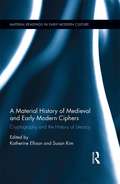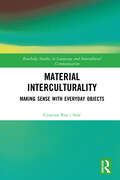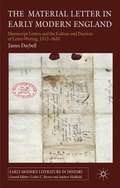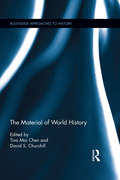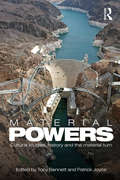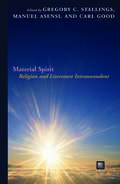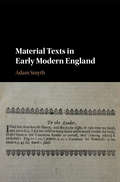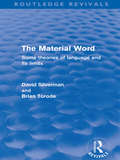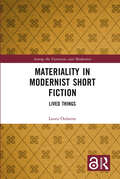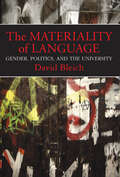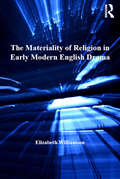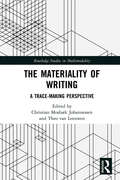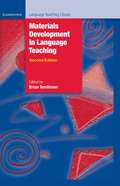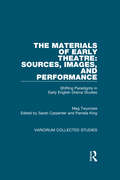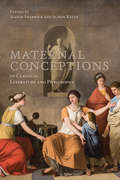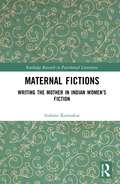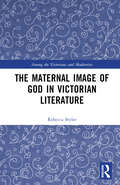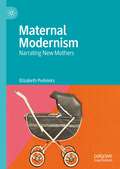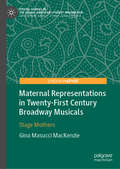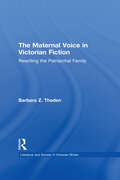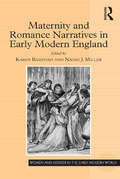- Table View
- List View
A Material History of Medieval and Early Modern Ciphers: Cryptography and the History of Literacy (Material Readings in Early Modern Culture)
by Katherine Ellison Susan KimThe first cultural history of early modern cryptography, this collection brings together scholars in history, literature, music, the arts, mathematics, and computer science who study ciphering and deciphering from new materialist, media studies, cognitive studies, disability studies, and other theoretical perspectives. Essays analyze the material forms of ciphering as windows into the cultures of orality, manuscript, print, and publishing, revealing that early modern ciphering, and the complex history that preceded it in the medieval period, not only influenced political and military history but also played a central role in the emergence of the capitalist media state in the West, in religious reformation, and in the scientific revolution. Ciphered communication, whether in etched stone and bone, in musical notae, runic symbols, polyalphabetic substitution, algebraic equations, graphic typographies, or literary metaphors, took place in contested social spaces and offered a means of expression during times of political, economic, and personal upheaval. Ciphering shaped the early history of linguistics as a discipline, and it bridged theological and scientific rhetoric before and during the Reformation. Ciphering was an occult art, a mathematic language, and an aesthetic that influenced music, sculpture, painting, drama, poetry, and the early novel. This collection addresses gaps in cryptographic history, but more significantly, through cultural analyses of the rhetorical situations of ciphering and actual solved and unsolved medieval and early modern ciphers, it traces the influences of cryptographic writing and reading on literacy broadly defined as well as the cultures that generate, resist, and require that literacy. This volume offers a significant contribution to the history of the book, highlighting the broader cultural significance of textual materialities.
Material Interculturality: Making Sense with Everyday Objects (Routledge Studies in Language and Intercultural Communication)
by Cristina Ros i SoléThis book shows how objects can create new linguistic and cultural orders, spotlighting the ways in which everyday collections help make the world anew by rearranging its materiality and how multilingual speakers make meanings without words.Adopting an innovative approach to intercultural research drawing on work from visual and multisensorial ethnography, Ros i Solé critically reflects on what we know as interculturality by going beyond the verbal and the more-than-human to understand languages and cultures. This book expands the meaning of interculturality by seeing it as the result of the relations between people, places, and materiality. Using everyday multilingual artefacts such as clothes, cookie-cutters, LPs, books, and pens, it presents a new semiotic multilingual landscape where the intercultural is closely connected to the ground, and it is felt, rehearsed, and re-enacted through the stories and the memories contained in multilingual objects.This book will be of particular interest to students and scholars in intercultural communication, multilingualism, language education, and applied linguistics.
The Material Letter in Early Modern England
by James DaybellThe first major socio-cultural study of manuscript letters and letter-writing practices in early modern England. Daybell examines a crucial period in the development of the English vernacular letter before Charles I's postal reforms in 1635, one that witnessed a significant extension of letter-writing skills throughout society.
The Material of World History (Routledge Approaches to History)
by Tina Mai Chen David S. ChurchillThis volume considers the confluence of World History and historical materialism, with the following guiding question in mind: given developments in the field of historical materialism concerned with the intersection of race, gender, labour, and class, why is it that within the field of World History, historical materialism has been marginalized, precisely as World History orients toward transnational socio-cultural phenomenon, micro-studies, or global histories of networks? Answering this question requires thinking, in an inter-related manner, about both the development of World History as a discipline, and the place of economic determinism in historical materialism. This book takes the position that historical materialism (as applied to the field of World History) needs to be more open to the methodological diversity of the materialist tradition and to refuse narrowly deterministic frameworks that have led to marginalization of materialist cultural analysis in studies of global capitalism. At the same time, World History needs to be more self-critical of the methodological diversity it has welcomed through a largely inclusionary framework that allows the material to be considered separately from cultural, social, and intellectual dimensions of global processes.
Material Powers: Cultural Studies, History and the Material Turn (CRESC)
by Tony Bennett Patrick JoyceThis edited collection is a major contribution to the current development of a ‘material turn’ in the social sciences and humanities. It does so by exploring new understandings of how power is made up and exercised by examining the role of material infrastructures in the organization of state power and the role of material cultural practices in the organization of colonial forms of governance. A diverse range of historical examples is drawn on in illustrating these concerns – from the role of territorial engineering projects in seventeenth-century France through the development of the postal system in nineteenth-century Britain to the relations between the state and road-building in contemporary Peru, for example. The colonial contexts examined are similarly varied, ranging from the role of photographic practices in the constitution of colonial power in India and the measurement of the bodies of the colonized in French colonial practices to the part played by the relations between museums and expeditions in the organization of Australian forms of colonial rule. These specific concerns are connected to major critical re-examination of the limits of the earlier formulations of cultural materialism and the logic of the ‘cultural turn’. The collection brings together a group of key international scholars whose work has played a leading role in debates in and across the fields of history, visual culture studies, anthropology, geography, cultural studies, museum studies, and literary studies.
Material Spirit: Religion and Literature Intranscendent (Perspectives in Continental Philosophy)
by Manuel Asensi Carl GoodThe essays in this collection examine philosophical, religious, and literary or artistic texts using methodologies and insights that have grown out of reflection on literature and art. In them, them phrase “material spirit” becomes a point of departure for considering the continuing spectral effects of religious texts and concerns in ways that do not simply call for, or assume, new orrenewed forms of religiosity.The writers in this collection seek to examine religion beyond traditional notions of transcendence: Their topics range from early Christian religious practices to global climate change. Some of the essays explore religious themes or tones in literary texts, for example, works by Wordsworth, Hopkins, Proust, Woolf, and Teresa of Avila. Others approach—in a literarycriticalmood—philosophical or para-philosophical writers such as Bataille, Husserl, Derrida, and Benjamin. Still others treat writers of a more explicitly religious orientation, such as Augustine, Rosenzweig, or Bernard of Clairvaux.
Material Texts in Early Modern England
by Adam SmythWhat was a book in early modern England? By combining book history, bibliography and literary criticism, Material Texts in Early Modern England explores how sixteenth- and seventeenth-century books were stranger, richer things than scholars have imagined. Adam Smyth examines important aspects of bibliographical culture which have been under-examined by critics: the cutting up of books as a form of careful reading; book destruction and its relation to canon formation; the prevalence of printed errors and the literary richness of mistakes; and the recycling of older texts in the bodies of new books, as printed waste. How did authors, including Herbert, Jonson, Milton, Nashe and Cavendish, respond to this sense of the book as patched, transient, flawed, and palimpsestic? Material Texts in Early Modern England recovers these traits and practices, and so crucially revises our sense of what a book was, and what a book might be.
The Material Word: Some theories of language and its limits (Routledge Revivals)
by David Silverman Brian TorodeFirst published in 1980, this reissue is a study of the sociology of language, which aims to bridge the gap between textbook and monograph by alternating chapters of explication and analysis. A chapter outlining a particular theory and suggesting general criticisms is followed by a chapter offering an original application of that theory. The aim of the authors is to treat text and talk as the site of specific practices which sustain or subvert particular relations between appearance and reality.
Materialist Film (Routledge Library Editions: Cinema)
by Peter GidalA polemical introduction to the avant-garde and experimental in film (including making and viewing), Materialist Film is a highly original, thought-provoking book. Thirty-seven short chapters work through a series of concepts which will enable the reader to deal imaginatively with the contradictory issues produced by experimental film. Each concept is explored in conjunction with specific films by Andy Warhol, Malcolm LeGrice, Lis Rhodes, Jean-Luc Goddard, Rose Lowder, Kurt Kren, and others. Peter Gidal draws on important politico-aesthetic writings, and uses some of his own previously published essays from Undercut, Screen, October, and Millennium Film Journal to undertake this concrete process of working through abstract concepts. Originally published in 1989.
Materiality in Modernist Short Fiction: Lived Things (Among the Victorians and Modernists)
by Laura OulanneMateriality in Modernist Short Fiction provides a fresh approach to reading material things in modern fiction, accounting for the interplay of the material and the cultural. This volume investigates how Djuna Barnes, Katherine Mansfield, and Jean Rhys use the short story form to evoke the material world as both living and lived, and how the spaces they create for challenging gendered social norms can also be nonanthropocentric spaces for encounters between the human and the nonhuman. Using the unique knowledge created by literary works to spark new conversations between phenomenology, cognitive studies, and new materialisms, complemented with a feminist perspective, this book explores how literature can touch the basic experience of being in, feeling and making sense of a material world that is itself alive and active. From a sensitive reading of how three women used the material world to make their readers see, feel, and question the norms shaping our experience, this volume draws a theory of reading affective materiality that illuminates modernism and the short story form but also reaches beyond them.
The Materiality of Language: Gender, Politics, and the University
by David BleichA critique of male-dominated modes of language use, their roots in higher education, their effects, and their spill over into popular culture.David Bleich sees the human body, its affective life, social life, and political functions as belonging to the study of language. In The Materiality of Language, Bleich addresses the need to end centuries of limiting access to language and its many contexts of use. To recognize language as material and treat it as such, argues Bleich, is to remove restrictions to language access due to historic patterns of academic censorship and unfair gender practices. Language is understood as a key path in the formation of all social and political relations, and becomes available for study by all speakers, who may regulate it, change it, and make it flexible like other material things.“A potentially foundational text in an emergent field [of] language studies, whose work is to break up the monopoly Linguistics and Philosophy have had on the study of language. . . . The insight that the affective operation of language is elided in nearly all approaches to [language] acquisition is brilliant and astounding. . . . The analysis of subject creation as an affective process of recognizing and sharing the same affective state and language as the means for materializing affective states . . . is fascinating and persuasive. . . . One of the book’s distinctive features is the use of gender as a key normative analytical lens throughout. It would be difficult to exaggerate how rare this is among language thinkers, and how productive it is for the arguments here.” —Mary Louise Pratt, New York University“A powerful, first-rate book on a crucial topic. It offers a great interpretation of the sacralization and ascendancy of Latin as a language supporting what Bleich calls ‘an elite group of men.’ . . . This is a brilliant codebook to academic language and its coercions.” —Dale Bauer, University of Illinois/DESC>literary theory;semiotics;literary criticism;philosophy;language philosophy;philosophy of language;gender studies;social science;language studies;communication studies;language arts;language disciplines;gender;sex;language;rhetoric;academic language;colloquial language;language political aspects;language sex differences;language and genderLIT006000 LITERARY CRITICISM / Semiotics & TheoryPHI038000 PHILOSOPHY / LanguageSOC032000 SOCIAL SCIENCE / Gender StudiesLAN004000 LANGUAGE ARTS & DISCIPLINES / Communication Studies 9780253016508Well-Tempered Woodwinds: Friedrich von Huene and the Making of Early Music in a New WorldGeoffrey Burgess
The Materiality of Religion in Early Modern English Drama (Studies In Performance And Early Modern Drama Ser.)
by Elizabeth WilliamsonThe Materiality of Religion in Early Modern English Drama is the first book to present a detailed examination of early modern theatrical properties informed by the complexity of post-Reformation religious practice. Although English Protestant reformers set out to destroy all vestiges of Catholic idolatry, public theater companies frequently used stage properties to draw attention to the remnants of traditional religion as well as the persistent materiality of post-Reformation worship. The Materiality of Religion in Early Modern English Drama explores the relationship between popular culture and theatrical performance by considering the social history and dramatic function of these properties, addressing their role as objects of devotion, idolatry, and remembrance on the professional stage. Rather than being aligned with identifiably Catholic or Protestant values, the author reveals how religious stage properties functioned as fulcrums around which more subtle debates about the status of Christian worship played out. Given the relative lack of existing documentation on stage properties, The Materiality of Religion in Early Modern English Drama employs a wide range of source materials-including inventories published in the Records of Early English Drama (REED) volumes-to account for the material presence of these objects on the public stage. By combining historical research on popular religion with detailed readings of the scripts themselves, the book fills a gap in our knowledge about the physical qualities of the stage properties used in early modern productions. Tracing the theater's appropriation of highly charged religious properties, The Materiality of Religion in Early Modern English Drama provides a new framework for understanding the canonization of early modern plays, especially those of Shakespeare.
The Materiality of Writing: A Trace Making Perspective (Routledge Studies in Multimodality)
by Christian Mosbæk Johannessen Theo van LeeuwenThis book examines the materiality of writing. It adopts a multimodal approach to argue that writing as we know it is only a small part of the myriad gestures we make, practices we engage in, and media we use in the process of trace-making. Taking a broad view of the act of writing, the volume features contributions from both established and up-and-coming scholars from around the world and incorporates a range of methodological and theoretical perspectives, from fields such as linguistics, philosophy, psychology of perception, design, and semiotics. This interdisciplinary framework allows readers to see the relationships between writing and other forms of "trace-making", including architectural drawings, graphic shapes, and commercial logos, and between writing and reading, with a number of illustrations highlighting the visual data used in the forms and studies discussed. The book also looks forward to the future, discussing digital media and new technology and their implications for trace-making. This pioneering volume will be of interest to scholars and researchers in multimodality, literacy, cognitive neuroscience, design theory, discourse analysis, and applied linguistics.
Materials and Methods in ELT: A Teacher's Guide (Applied Language Studies #1)
by Jo McDonough Christopher ShawMaterials and Methods in ELT is an essential resource for teachers or for those engaged in taking professional courses relating to all aspects of English language teaching. Now available in its 3rd edition, this popular teachers’ guide offers a comprehensive and useful introduction to the principles and practice of teaching English as a foreign/second language. It examines the ideas behind current methodology and teaching materials, in addition to offering a practical guide to approaching materials and methods, evaluation and adaptation, technology for materials and methods, and teaching in under-resourced classrooms. These principles are then related to the individual language skills of reading, listening, speaking, and writing. The authors examine the different methodologies available to teachers for organizing and running an ELT classroom; discussing group and pair work, individualization, classroom observation, and the teachers’ role in the contemporary ELT context. Updated throughout, the 3rd edition features a new section on technology for materials and methods, as well as a new chapter on IT in English language teaching, and inclusion of new samples from current teaching materials.
Materials Development in Language Teaching
by Brian TomlinsonMaterials Development in Language Teaching aims to help readers apply current theoretical principles and research findings to the practical realities of developing and exploiting classroom materials. The authors also suggest new ideas and directions in materials development, which readers can pursue for themselves. This book is accessible to readers with little previous experience in the field, and is essential reading for all those involved in developing materials for language teaching. In the second edition of this highly popular title, each chapter has been comprehensively revised and updated to take into account both recent research and the significant technological developments since the first edition was published in 1998. Two new chapters have been added to assess the potential of electronic media for materials development. These chapters include an overview of the technologies available, as well as individual case studies and activities.
The Materials of Early Theatre: Shifting Paradigms in Early English Drama Studies (Variorum Collected Studies)
by Meg TwycrossCollected Studies CS 1068 The essays selected for this volume are chosen to reflect the important and intersecting ways in which over the last forty years Meg Twycross has shifted paradigms for people reading early English religious drama. The focus of Meg Twycross’s research has been on performance in its many aspects, and this volume chooses four of the most important strands of her work - the York plays; new ways of understanding acting and performance in late medieval theatre, particularly in Britain and across Europe; why scenes are staged in the ways they are, verbally and by extrapolation visually, by close reading of texts against the background of medieval theology; and the attention paid to wider contexts of medieval theatre - concentrating especially on essays that are not easily available today. These thematic strands are reflective of Meg Twycross’s major contribution to the field. They also represent those areas from her wider work which will have most utility and value for those, whether students or senior specialists in areas beyond early drama, who are looking for ways into understanding English medieval plays. The crucial work that has been done here has opened new perspectives on late medieval theatre, and will allow new generations to begin their study and research from further along the road.
Maternal Abandonment and Queer Resistance in Twenty-First-Century Swedish Literature
by Jenny BjörklundThis book questions why so many mothers leave their families in twenty-first-century Swedish literature, analyzing literary representations of maternal abandonment in relation to sociopolitical discourses. The volume draws on a queer-theoretical framework in order to highlight norm-critical dimensions, failure, and resistance in literature about motherhood. Jenny Björklund argues that novels about mothers who leave can be understood as ways to problematize and challenge Swedish-branded values like gender equality and a progressive family politics that promotes ideals of involved parenthood, the nuclear family, and pronatalism. The book also raises questions beyond the Swedish context about maternal ambivalence, family politics, and privilege and discusses how literature can work as resistance and provide alternatives to the current social order.
Maternal Conceptions in Classical Literature and Philosophy (Phoenix Supplementary Volumes #57)
by Alison Sharrock Alison KeithUnlike many studies of the family in the ancient world, this volume presents readings of mothers in classical literature, including philosophical and epigraphic writing as well as poetic texts. Rather than relying on a male viewpoint, the essays offer a female perspective on the lifecycle of motherhood. Although almost all ancient authors are men, this book nevertheless aims to unpack carefully the role of the mother – not as projected by the son or other male relations, but from a woman’s own experiences – in order to better understand how they perceived themselves and their families. Because the primary interest is in the mothers themselves, rather than the authors of the texts in which they appear, the work is organized according to the lifecycle of motherhood instead of the traditional structure of the chronology of male authors. The chronology of the male authors ranges from classical Greece to late antiquity, while the motherly lifecycle ranges from pre-conception to the commemoration of offspring who have died before their mothers.
Maternal Fictions: Writing the Mother in Indian Women’s Fiction (Routledge Research in Postcolonial Literatures)
by Indrani KarmakarThis book constitutes a feminist literary analysis of motherhood as presented in selected Indian women’s fictions across a diverse range of geographical, linguistic, class and caste contexts. Situated at the crossroads of motherhood studies and literary studies, this book offers a rigorous examination of the prosody and politics of motherhood in this corpus. In its five thematically focused chapters, the book scrutinises in depth such key concerns as maternal ambivalence; maternal agency and caste; mother–daughter relationships; motherhood and diaspora; and non-biological motherhood. It attempts to understand the literary ramifications of these issues in order to identify the ways in which fiction writers reconceive of the notion of motherhood and maternal identities from and against multiple perspectives. Another pressing concern is whether these Indian women writers’ visions furnish readers with any different understandings of motherhood as compared to dominant Western feminist discourses. Maternal Fictions advances feminist literary criticism in the specific area of Indian women’s writing and the overarching areas of motherhood and literature by acting as a launchpad into a complex constellation of ideas concerning motherhood. The fictional universe is at once ambivalent, diverse, contingent, grounded in a specific location, and yet well placed to converse with discourses emanating from other times and places.
Maternal Fictions: Stendahl, Sand, Rachilde, and Bataille
by Maryline LukacherStendhal, George Sand, Rachilde, Georges Bataille: Forgoing the patronym, with its weight of meaning, these modern French writers renamed themselves in their work. Their use of pseudonyms, as Maryline Lukacher demonstrates in this provocative study, is part of a process to subvert the name of the father and explore the suppressed relation to the figure of the mother. Combining psychoanalytic criticism, feminist theory, and literary analysis, Maternal Fictions offers a complex psychological portrait of these writers who managed at once to challenge patriarchal authority and at the same time attempt to return to the maternal.Through readings of Armance, Le Rouge et le noir, La Vie de Henry Brulard, and Les Cenci, Lukacher exposes Stendhal's preoccupation with his dead mother, who is obsessively retrieved throughout his work. George Sand's identity is, in effect, divided between two mothers, her biological mother and her grandmother, and in Histoire de ma vie, Indiana, and Mauprat, we see the writer's efforts to break the impasse created by this divided identity. In the extraordinary but too little known work of Rachilde (Marguerite Eymery), Lukacher finds the maternal figure identified as the secret inner force of patriarchal oppression. This resistance to feminism continues in the pseudonymous work of Georges Bataille. In Ma mère, Le coupable, and L'Expérience intérieure Lukacher traces Bataille's representation of the mother as a menacing, ever subversive figure who threatens basic social configurations.Maternal Fictions establishes a new pseudonymous genealogy in modern French writing that will inform and advance our understanding of the act of self-creation that occurs in fiction.
The Maternal Image of God in Victorian Literature (Among the Victorians and Modernists)
by Rebecca StylerThis book is the study of a religious metaphor: the idea of God as a mother, in British and US literature 1850–1915. It uncovers a tradition of writers for whom divine motherhood embodied ideals felt to be missing from the orthodox masculine deity. Elizabeth Gaskell, Josephine Butler, George Macdonald, Frances Hodgson Burnett and Charlotte Perkins Gilman independently reworked their inherited faith to create a new symbol that better met their religious needs, based on ideal Victorian notions of motherhood and ‘Mother Nature’. Divine motherhood signified compassion, universal salvation and a realised gospel of social reform led primarily by women to establish sympathetic community. Connected to Victorian feminism, it gave authority to women’s voices and to ‘feminine’ cultural values in the public sphere. It represented divine immanence within the world, often providing the grounds for an ecological ethic, including human–animal fellowship. With reference also to writers including Charlotte Brontë, Anna Jameson, Charles Kingsley, Elizabeth Charles, Theodore Parker, Harriet Beecher Stowe, Mary Baker Eddy and authors of literary utopias, this book shows the extent of maternal theology in Victorian thought and explores its cultural roots. The book reveals a new way in which Victorian writers creatively negotiated between religious tradition and modernity.
Maternal Modernism: Narrating New Mothers
by Elizabeth PodnieksDrawing on the figure and discourses of the Victorian fin-de-siècle New Woman, this book examines women writers who struggled with conservative, patriarchal ideologies of motherhood in novels, periodicals and life writings of the long modernist period. It shows how these writers challenged, resisted, adapted and negotiated traditional ideas with their own versions of new motherhood, with needs for identities and experiences beyond maternity. Tracing the period from the end of the nineteenth century through the twentieth, this study explores how some of the numerous elements and forces we identify with modernism are manifested in equally diverse and often competing representations of mothers, mothering and motherhood. It investigates how historical personages and fictional protagonists used and were constructed within textual spaces where they engaged critically with the maternal as institution, identity and practice, from perspectives informed by gender, sexuality, nationhood, race and class. The matrifocal literatures examined in this book exemplify how feminist motherhoods feature as a prominent thematic of the long modernist era and how rebellious New Woman mothers provocatively wrote maternity into text and history.
Maternal Representations in Twenty-First Century Broadway Musicals: Stage Mothers (Pivotal Studies in the Global American Literary Imagination)
by Gina Masucci MacKenzieMaternal Representations in Twenty-First Century Broadway Musicals: Stage Mothers analyzes Broadway productions within the context of their presentation and assessment of motherhood and the variety of roles for mother figures. Using a frame of feminist and psychoanalytical positions, Gina MacKenzie establishes, defines, and interprets mother figures in contemporary Broadway, according to original categorizations of the absent, inconsequential, and overbearing mothers. MacKenzie considers how and why commercial representation of mother figures are limited and predominantly negative, even as fiction, poetry, and other forms of drama offer a much wider and progressive view of the varieties of motherhood possible in society, asserting the need for greater representation of mother figures in commercial musical theatre today.
The Maternal Voice in Victorian Fiction: Rewriting the Patriarchal Family (Literature and Society in Victorian Britain #2)
by Barbara Z. ThadenFirst published in 1997. Routledge is an imprint of Taylor & Francis, an informa company.
Maternity and Romance Narratives in Early Modern England (Women and Gender in the Early Modern World)
by Karen Bamford Naomi J. MillerThough recent scholarship has focused both on motherhood and on romance literature in early modern England, until now, no full length volume has addressed the notable intersections between the two topics. This collection contributes to the scholarly investigation of maternity in early modern England by scrutinizing romance narratives in various forms, considering motherhood not as it was actually lived, but as it was figured in the fantasy world of romance by authors ranging from Edmund Spenser to Margaret Cavendish. Contributors explore the traditional association between romance and women, both as readers of fiction and as tellers of ’old wives’ tales,’ as well as the tendency of romance plots, with their emphasis on the family and its reproduction, to foreground matters of maternity. Collectively, the essays in this volume invite reflection on the uses to which Renaissance culture put maternal stereotypes (the virgin mother, the cruel step-dame), as well as the powerful fears and desires that mothers evoke, assuage and sometimes express in the fantasy world of romance.
